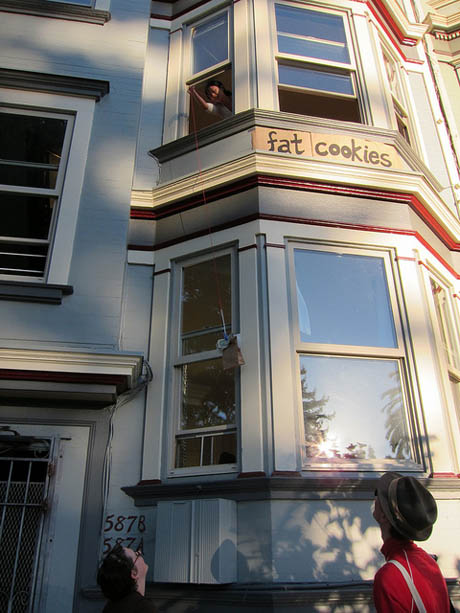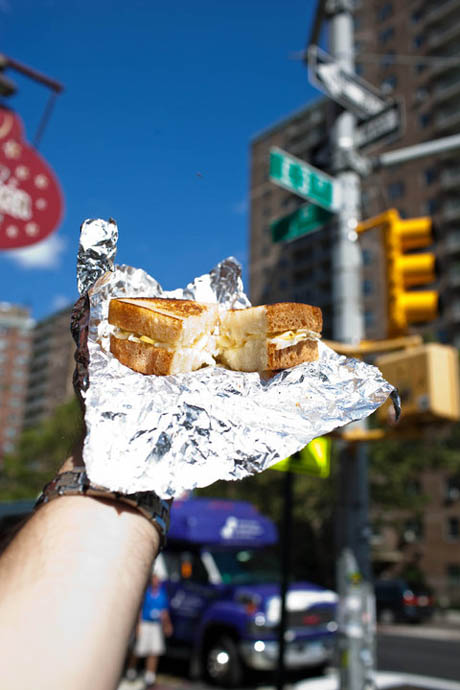If you’re in San Francisco on Tuesday night, don’t miss this conversation about “the emerging underground food movement in San Francisco and around the country,” taking place at 7:00pm at the Studio for Urban Projects.
Moderated by the lovely Rosie Branson Gill, of 18 Reasons, and featuring Sandor Katz (author of The Revolution will not be Microwaved and Wild Fermentation), Iso Rabins (founder of ForageSF and the Underground Farmer’s Market), and artists Ted Purves and Susanne Cockrell (the artists behind The Meadow Network), the panel is set to discuss “cow shares, market memberships, food swaps, pop-up restaurants, and backyard harvesting,” and the ways in which these strategies are transforming “economics, food distribution, and community.”

IMAGE: Until they were shut down by the SFPD, the entrepreneurs behind Fat Cookies delivered their fresh-baked goods to customers by way of a bag and string hoist, which, as BoingBoing points out, is “a time-honored cocaine dealer’s technique.” Photo by sandwichgirl.
I was originally scheduled to join the discussion, before other commitments unfortunately got in the way, and I would have loved nothing better than to listen, learn, and share my own fascination with food’s alternative geographies, from secret backyard chickens and underground lobster roll dealers to endangered species snuff dining, and roadkill phone trees.
In lieu of that, here is a short piece on illegal bushmeat networks that Geoff Manaugh (of BLDGBLOG) and I wrote for the New City Reader’s Food Issue last November (you can now read the entire issue online, so don’t miss Sarah Rich’s accompanying, wonderful essay on humanure and other types of renegade composting).

IMAGE: For a delicious and illicit lunch in the East Village, you can text “Ronnie, a former investment banker who now hawks illegal homemade grilled cheese sandwiches,” reports Sarah Rich in the New City Reader. Photo by Michael Stewart.
Meat Market
by Geoff Manaugh and Nicola Twilley, for the New City Reader
Hundreds of tonnes of bushmeat — defined by the Bushmeat Crisis Task Force as “any wildlife species, including threatened and endangered, used for meat including: elephant; gorilla; chimpanzee, and other primates; forest antelope (duikers); crocodile; porcupine; bush pig; cane rat; pangolin; monitor lizard; guinea fowl; etc.” — are smuggled through international airports such as Paris-Charles De Gaulle, Chicago O’Hare, and New York’s JFK, every week. It’s destination: local dinner plates.

IMAGE: Bushmeat seized during a Chicago raid, via.
In a July 2010 raid on an African antiquities store located on Chicago’s west side, monkey heads, and dead cane rats were seized by agents of the U.S. Fish and Wildlife Service. “In a brown cardboard box labeled ‘Blue Brand Spread for Bread,’” the Chicago Tribune reported, “agents found 14 cane rats impaled on sticks, six monkey heads, numerous impaled mice, and a pit-viper skull.” In the process, the raid uncovered just one hub of “a robust but underground business: illegally smuggling meat to Chicago residents hungry for a taste from their African homelands.”
In Paris, exotic and illegal culinary imports such as “smoked anteater” have been popping up in neighborhood markets. In the city’s northerly 18th arrondissement, for instance, “everyone knows bushmeat is sold,” a local butcher named Hassan Kaouti explained to the Huffington Post earlier this year, “and they even know where to buy it.” One shop owner, identified as Madame Toukine, “receives special deliveries of crocodile and other bushmeat each weekend.”
The demand for bushmeat is not solely motivated by Proustian nostalgia; in fact, many of the seized delicacies are required for cultural and religious ceremonies. But while immigrant groups within the U.S. and Europe form complex underground meat distribution networks, back at its source, the bushmeat trade is enmeshed in its own ecosystem of pressing issues. These include the proliferation of illegal firearms, poaching in natural parks, native habitat loss, the extinction of already endangered species, and even the potential seeds of a global pandemic.
In a 2010 report issued by the Wildlife Conservation Society, bushmeat imported as food was revealed to harbor a host of zoonotic diseases, including Ebola and simian foamy virus. This latter realization has rung alarm bells in the halls of the Centers for Disease Control, who now fear that the next AIDS might arrive on U.S. shores through these underground networks of unregulated meat exchange.
In many ways, these shadow meat economies provide an unsettling parallel to the diseased and dangerous state of the United States’ existing, FDA-approved industrial food system. Nonetheless, in bushmeat, the forces of global trade and the threat of a future outbreak unexpectedly align in the guise of culinary tradition and cultural continuity, turning food into an epidemiological vector that transmits from rainforest to plate.

